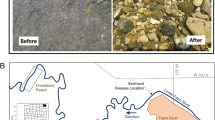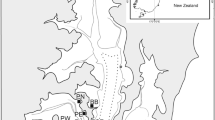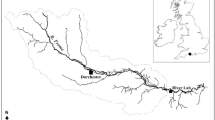Abstract
In soft-bottom sediments, consumers may influence ecosystem function more via engineering that alters abiotic resources than through trophic influences. Understanding the influence of bioturbation on physical, chemical, and biological processes of the water–sediment interface requires investigating top-down (consumer) and bottom-up (resource) forces. The objective of the present study was to determine how consumer bioturbation mode and sediment properties interact to dictate the hydrologic function of experimental filtration systems clogged by the deposition of fine sediments. Three fine-grained sediments characterized by different organic matter (OM) and pollutant content were used to assess the influence of resource type: sediment of urban origin highly loaded with OM and pollutants, river sediments rich in OM, and river sediments poor in OM content. The effects of consumer bioturbation (chironomid larvae vs. tubificid worms) on sediment reworking, changes in hydraulic head and hydraulic conductivity, and water fluxes through the water–sediment interface were measured. Invertebrate influences in reducing the clogging process depended not only on the mode of bioturbation (construction of biogenic structures, burrowing and feeding activities, etc.) but also on the interaction between the bioturbation process and the sediments of the clogging layer. We present a conceptual model that highlights the importance of sediment influences on bioturbation and argues for the integration of bottom-up influence on consumer engineering activities.




Similar content being viewed by others
References
Aller RC (1994) Bioturbation and remineralization of sedimentary organic matter: effects of redox oscillation. Chem Geol 114:331–345
Altmann D, Stief P, Amann R, de Beer D (2004) Nitrification in freshwater sediments as influenced by insect larvae: quantification by microsensors and fluorescence. Microb Ecol 48:145–153
Blaschke AP, Steiner KH, Schmalfuss R, Gutknecht D, Sengschmitt D (2003) Clogging processes in hyporheic interstices of an impounded river, the Danube at Vienna, Austria. Int Rev Hydrobiol 88:397–413
Bouché ML, Habets F, Biagianti-Risbourg S, Vernet G (2000) Toxic effects and bioaccumulation of cadmium in the aquatic oligochaete Tubifex tubifex. Ecotoxicol Environ Saf 46:246–251
Boulton AJ, Findlay S, Marmonier P, Stanley EH, Valett HM (1998) The functional significance of the hyporheic zone in streams and rivers. Annu Rev Ecol Syst 29:59–81
Brinkhurst RO, Kennedy CR (1965) Studies on the biology of the Tubificidae (Annelida, Oligochaeta) in a polluted stream. J Anim Ecol 34:429–443
Brunke M (1999) Colmation and depth filtration within streambeds: retention of particles in hyporheic interstices. Int Rev Hydrobiol 84:99–117
Brunke M, Gonser T (1997) The ecological significance of exchange processes between rivers and groundwater. Freshwater Biol 37:1–33
Buchanan JB (1984) Sediment analysis. In: Holme NA, McIntyre AD (eds) Methods for the study of marine benthos. Blackwell, Oxford, pp 41–64
Bulling MT, Solan M, Dyson KE, Hernandez-Milian G, Luque P, Pierce GJ, Raffaelli D, Paterson DM, White PCL (2008) Species effects on ecosystem processes are modified by faunal responses to habitat composition. Oecologia 158:511–520
Carpenter SR, Kitchell JF, Hodgson JR (1985) Cascading trophic interactions and lake productivity. Bioscience 35:634–639
Carpenter SR, Ludwig D, Brock WA (1999) Management of eutrophication for lakes subject to potentially irreversible change. Ecol Appl 9:751–771
Chapin FS, Schulze E-D, Mooney HA (1992) Biodiversity and ecosystem processes. Trends Ecol Evol 7:107–108
Chebbo G, Mouchel JM, Saget A, Gousailles M (1995) La pollution des rejets urbains par temps de pluie: flux, nature et impacts. Tech Sci Method 11:796–804
Dahm CN, Grimm NB, Marmonier P, Valett HM, Vervier P (1998) Nutrient dynamics at the interface between surface waters and groundwaters. Freshwater Biol 40:427–451
Dale RK, Miller DC (2008) Hydrologic interactions of infaunal polychaetes and intertidal groundwater discharge. Mar Ecol Prog Ser 363:205–215
Darwin C (1881) On the formation of vegetable mould through the action of worms with observation of their habits. Murray, London
Davis RB (1974) Stratigraphic effects of tubificids in profundal lake sediments. Limnol Oceanogr 19:466–488
Deeds JR, Klerks PL (1999) Metallothionein-like proteins in the freshwater oligochaete Limnodrilus udekemianus and their role as a homeostasic mechanism against cadmium toxicity. Environ Pollut 106:381–389
Fellows CS, Valett MH, Dahm CN (2001) Whole-stream metabolism in two montane streams: contribution of the hyporheic zone. Limnol Oceanogr 46:523–531
François F, Poggiale JC, Durbec JP, Stora G (1997) A new approach for the modelling of sediment reworking induced by a macrobenthic community. Acta Biotheor 45:295–319
François F, Gerino M, Stora G, Durbec JP, Poggiale JC (2002) Functional approach to modelling sediment reworking by gallery-forming macrobenthic organisms: modelling and application with the polychaete Nereis diversicolor. Mar Ecol Prog Ser 229:127–136
Gardner LR, Sharma P, Moore WS (1987) A regeneration model for the effect of bioturbation by fiddler crabs on [210]Pb profiles in salt marsh sediments. J Environ Radioact 5:25–36
Gaudet JP, Jegat H, Vachaud G, Wierenga PJ (1977) Solute transfer with exchange between mobile and stagnant water, through unsaturated sand. Soil Sci Soc Am J 41:665–671
Gerino M (1990) The effects of bioturbation on particle redistribution in Mediterranean coastal sediment – preliminary results. Hydrobiologia 207:251–258
Gerino M, Stora G, François-Carcaillet F, Gilbert F, Poggiale JC, Mermillod-Blondin F, Desrosiers G, Vervier P (2003) Macro-invertebrate functional groups in freshwater and marine sediments: a common mechanistic classification. Vie Milieu 53:221–232
Giller PS, Hillebrand H, Berninger UG, Gessner MO, Hawkins S, Inchausti P, Inglis C, Leslie H, Malmqvist B, Monaghan MT, Morin PJ, O’Mullan G (2004) Biodiversity effects on ecosystem functioning: emerging issues and their experimental test in aquatic environments. Oikos 104:423–436
Hakenkamp CC, Palmer MA (2000) The ecology of hyporheic meiofauna. In: Jones JA, Mulholland PJ (eds) Streams and groundwaters. Academic Press, New York, pp 307–336
Hansen K, Kristensen E (1998) The impact of the polychaete Nereis diversicolor and enrichment with macroalgal (Chaetomorpha linum) detritus on benthic metabolism and nutrient dynamics in organic-poor and organic-rich sediment. J Exp Mar Biol Ecol 231:201–223
Harvey JW, Wagner BJ (2000) Quantifying hydrologic interactions between streams and their subsurface hyporheic zones. In: Jones JA, Mulholland PJ (eds) Streams and groundwaters. Academic Press, New York, pp 3–44
Hedges JI, Stern JH (1984) Carbon and nitrogen determinations of carbonate-containing solids. Limnol Oceanogr 29:657–663
Hulot FD, Lacroix G, Lescher-Moutoue FO, Loreau M (2000) Functional diversity governs ecosystem response to nutrient enrichment. Nature 405:340–344
Jones CG, Lawton JH, Shachak M (1994) Organisms as ecosystem engineers. Oikos 69:373–386
Jury WA, Roth K (1990) Transfer functions and solute movement through soils – theory and applications. Birkhäuser, Basel
Kreutzweiser DP, Capell SS, Good KP (2005) Effects of fine sediment inputs from a logging road on stream insect communities: a large-scale experimental approach in a Canadian headwater stream. Aquat Ecol 39:55–66
Kristensen E (2000) Organic matter diagenesis at the oxic/anoxic interface in coastal marine sediments, with emphasis on the role of burrowing animals. Hydrobiologia 426:1–24
Matthaei CD, Weller F, Kelly DW, Townsend CR (2006) Impacts of fine sediment addition to tussock, pasture, dairy and deer farming streams in New Zealand. Freshwater Biol 51:2154–2172
McCall PL, Fisher JB (1980) Effects of tubificid oligochaetes on physical and chemical properties of lake Erie sediments. In: Brinkhurst RO, Cook DG (eds) Aquatic oligochaete biology. Plenum, New-York, pp 253–317
McCall PL, Tevesz MJS (1982) The effects of benthos on physical properties of freshwater sediments. In: McCall PL, Tevesz MJS (eds) Animal-sediment relations. The biogenic alteration of sediments. Plenum, New York, pp 105–176
McLachlan AJ, Cantrell MA (1976) Sediment development and its influence on the distribution and tube structure of Chironomus plumosus L. (Chironomidae, Diptera) in a new impoundment. Freshwater Biol 6:437–443
McQueen DJ, Johannes MRS, Post JR, Stewart TJ, Lean DRS (1989) Bottom-up and top-down impacts on fresh-water pelagic community structure. Ecol Monogr 59:289–309
Mermillod-Blondin F, Rosenberg R (2006) Ecosystem engineering: the impact of bioturbation on biogeochemical processes in marine and freshwater benthic habitats. Aquat Sci 68:434–442
Mermillod-Blondin F, Creuze des Chatelliers M, Gerino M, Gaudet JP (2000) Testing the effect of Limnodrilus sp. (Oligochaeta, Tubificidae) on organic matter and nutrient processing in the hyporheic zone: a microcosm method. Arch Hydrobiol 149:467–487
Mermillod-Blondin F, Gaudet JP, Gerino M, Desrosiers G, Jose J, Creuzé des Châtelliers M (2004a) Relative influence of bioturbation and predation on organic matter processing in river sediments: a microcosm experiment. Freshwater Biol 49:895–912
Mermillod-Blondin F, Rosenberg R, François-Carcaillet F, Norling K, Mauclaire L (2004b) Influence of bioturbation by three benthic infaunal species on microbial community and biogeochemical processes in marine sediment. Aquat Microb Ecol 36:271–284
Meysman FJR, Middelburg JJ, Heip CHR (2006) Bioturbation: a fresh look at Darwin’s last idea. Trends Ecol Evol 21:688–695
Michaud E, Desrosiers G, Mermillod-Blondin F, Sundby B, Stora G (2006) The functional group approach to bioturbation. II. The effects of the Macoma balthica community on fluxes of nutrients and dissolved organic carbon across the sediment-water interface. J Exp Mar Biol Ecol 337:178–189
Nogaro G, Mermillod-Blondin F, François-Carcaillet F, Gaudet JP, Lafont M, Gibert J (2006) Invertebrate bioturbation can reduce the clogging of sediment: an experimental study using infiltration sediment columns. Freshwater Biol 51:1458–1473
Nogaro G, Mermillod-Blondin F, Montuelle B, Boisson JC, Bedell JP, Ohannessian A, Volat B, Gibert J (2007) Influence of a stormwater sediment deposit on microbial and biogeochemical processes in infiltration porous media. Sci Total Environ 377:334–348
Oades JM, Waters AG (1991) Aggregate hierarchy in soils. Aust J Soil Res 29:815–828
Orvain F, Sauriau P-G, Le Hir P, Guillou G, Cann P, Paillard M (2007) Spatio-temporal variations in intertidal mudflat erodability: Marennes-Oléron Bay, western France. Cont Shelf Res 27:1153–1173
Pitt R, Clark S, Field R (1999) Groundwater contamination potential from stormwater infiltration practices. Urban Water 1:217–236
Rehg KJ, Packman AI, Ren J (2005) Effects of suspended sediment characteristics and bed sediment transport on streambed clogging. Hydrol Process 19:413–427
Schälchli U (1992) The clogging of coarse gravel river beds by fine sediment. Hydrobiologia 235:189–197
Schoen R, Gaudet JP, Elrick DE (1999) Modelling of solute transport in a large undisturbed lysimeter, during steady-state water flux. J Hydrol 215:82–93
Spooner DE, Vaughn CC (2006) Context-dependent effects of freshwater mussels on stream benthic communities. Freshwater Biol 51:1016–1024
Stief P, De Beer D (2002) Bioturbation effects of Chironomus riparius on the benthic N-cycle as measured using microsensors and microbiological assays. Aquat Microb Ecol 27:175–185
Taniguchi M, Sharma ML (1990) Solute and heat transport experiments for estimating recharge rate. J Hydrol 119:57–69
Tisdall JM, Oades JM (1982) Organic matter and water-stable aggregates in soils. Eur J Soil Sci 33:141–163
Toride N, Feike JL, Van Genuchten MT (1993) A comprehensive set of analytical solutions for none-equilibrium solute transport with first-order decay and zero-order production. Water Resour Res 29:2167–2182
Valett HM, Morrice JA, Dahm CN, Campana ME (1996) Parent lithology, surface-groundwater exchange, and nitrate retention in headwater streams. Limnol Oceanogr 41:333–345
Van de Bund WJ, Goedkoop W, Johnson RK (1994) Effects of deposit-feeder activity on bacterial production and abundance in profundal lake sediment. J N Am Benthol Soc 13:532–539
Vitousek PM, Aber JD, Howarth RW, Likens GE, Matson PA, Schindler DW, Schlesinger WH, Tilman DG (1997) Human alteration of the global nitrogen cycle: sources and consequences. Ecol Appl 7:737–750
Wood PJ, Armitage PD (1997) Biological effects of fine sediment in the lotic environment. Environ Manage 21:203–217
Yamada H, Nakamura F (2002) Effect of fine sediment deposition and channel works on periphyton biomass in the Makomanai River, northern Japan. River Res Appl 18:481–493
Acknowledgments
This work was a part of the OTHU project (Experimental Observatory for Urban Hydrology) and was funded by the urban community of Lyon (COURLY) and the Rhône-Alpes region. This study was also supported by the Institut National des Sciences de l’Univers (n°03N51/0532, programme ECCO-PNBC) within the project Urbanization and stormwater pollution: impact on biological activities and biogeochemical functioning of water–sediment interfaces, and by the Agence Nationale de la Recherche (no. ANR-06-BDIV-007, programme Biodiversité) within the InBioProcess project. The experiments comply with the current laws of the country in which they were performed. We thank J.-P. Bedell, J.-C. Boisson, and B. Montuelle for fruitful discussions concerning experimental results; M. Creuzé Des Châtelliers for the collection of invertebrates; G. Bouger and A. Ohannessian for their help during sediment and water sampling; and P. Marmonier for his comments that improved the final version of this paper. We are also grateful to Pete Peterson, Rutger Rosenberg and one anonymous reviewer for their insightful comments.
Author information
Authors and Affiliations
Corresponding author
Additional information
Communicated by Pete Peterson.
Electronic supplementary material
Below is the link to the electronic supplementary material.
Rights and permissions
About this article
Cite this article
Nogaro, G., Mermillod-Blondin, F., Valett, M.H. et al. Ecosystem engineering at the sediment–water interface: bioturbation and consumer-substrate interaction. Oecologia 161, 125–138 (2009). https://doi.org/10.1007/s00442-009-1365-2
Received:
Accepted:
Published:
Issue Date:
DOI: https://doi.org/10.1007/s00442-009-1365-2




